Canada’s ambitious social policy spending may be over. Here’s how the 2022 federal budget lines up with the Liberals’ priorities.
Why It Matters
Mandate letters are detailed descriptions of a Prime Minister’s policy goals – and priorities – for their term. They give the social impact sector an idea of what issues the government may quickly fund, and what it may ignore outright.

Policy departments, social impact sector leaders, global development organizations, and grantmakers pore over Cabinet mandate letters to get a sense of the federal government’s priorities in the medium to long-term. Yet the real test of a government’s urgency to act is whether those priorities are actually funded in a budget.
With the Liberals set to govern until 2025 thanks to a confidence and supply agreement with the NDP, many of the commitments highlighted in the present Cabinet’s mandate letters could be fulfilled in spite of the Liberals’ minority status. But the 2022 budget faced some criticism from Canada’s social impact sector for being less bold and ambitious, especially around social safety nets for the most vulnerable people in the country, than previous pandemic budgets. While the Canadian government frequently talks about an ongoing COVID-19 recovery – pointing to a rebound in employment rates – many Canadians are still struggling to afford the basics of everyday life.
Prime Minister Justin Trudeau’s Cabinet has already made significant progress on several of their most ambitious social safety net promises – most notably the national childcare plan. What remains to be seen, based on the 2022 budget, is whether the Cabinet will hit its targets for several niche programs aimed at bolstering the social impact sector.

The take: Canada’s 2022 budget offers $732 million over the next year for the Access to COVID-19 Tools Accelerator, a way to improve vaccine access worldwide. However, Canada is still falling well short of its commitment to provide 200 million COVID doses to Global South countries in need through COVAX by the end of 2022. Only 14.2 million surplus doses have flowed from Canada to COVAX as of April 2022, according to Global Affairs Canada’s website, and the budget doesn’t mention any increases.
The 2022 budget says the Canadian government is “committed to increasing international assistance funding towards 2030”. A 2022-2023 estimate has Canada’s total international development spending at just over $8 billion – marginally more than the $7.5 billion spent during the 2021-2022 fiscal year. Whether it’ll be in line with the Sustainable Development Goals in a decade’s time is yet to be seen.
The Feminist International Assistance Policy is only mentioned once in the 2022 budget – specifically, that it exists, and the federal government is implementing it. Minister Harjit Sajjan’s mandate letter also calls on him to collaborate with new and existing partners in civil society – including Equality Fund, FinDev Canada, and the Sovereign Loans Program – on development funding while ensuring they’re all aligned with Canada’s feminist approach to development. It isn’t entirely clear whether the 2022 budget fulfils this line of Sajjan’s mandate letter.

The take: With Ontario signing onto Canada’s national childcare plan in late March 2022, all provinces and territories are now locked in. Fully launching the childcare system will take years, but Minister Karina Gould’s negotiations have been instrumental in getting every jurisdiction in the country without a childcare agreement on board. The system wasn’t mentioned in the 2022 budget because the first five years of funding – $30 billion – was already committed in 2021.
Gould’s agenda includes continuing to roll out the Community Service Recovery Fund. In March 2022, Employment and Social Development Canada put out a call for national funders to help distribute the Fund to organizations in need.
The Social Finance Fund, a major priority on Gould’s list, isn’t ready yet, but work is currently underway to find a wholesaler to deliver the funding once the Fund does go live. Its absence in the budget and its sheer size – $755 million – suggests it won’t be unveiled for at least another year.

The take: Canada’s 2022 budget was good to Hussen’s agenda – much of it was aimed at tackling housing affordability, building new homes, and easing the considerable costs of homeownership. The Housing Accelerator Fund, one of Hussen’s key priorities, is front and centre in the budget, promising $4 billion over five years to give financial incentives to municipalities willing to speed out housing development.
The National Action Plan on Combatting Hate is also in the budget, an $85 million plan to support community projects to fight bigotry and ensure Black and other racialized Canadians have equal access to jobs. Also included in the budget is targeted funding to fight anti-Semitism, anti-Black racism, and discrimination against LGBTQ people in Canada – although there is no new money for the Black-Led Philanthropic Endowment Fund set up in 2021.
And an Urban, Rural, and Northern Indigenous Housing Strategy is also prominently featured in the 2022 budget – a first in Canadian history. Around $6.3 billion in funding over the next seven years was announced in the budget to address the appalling state of Indigenous housing.
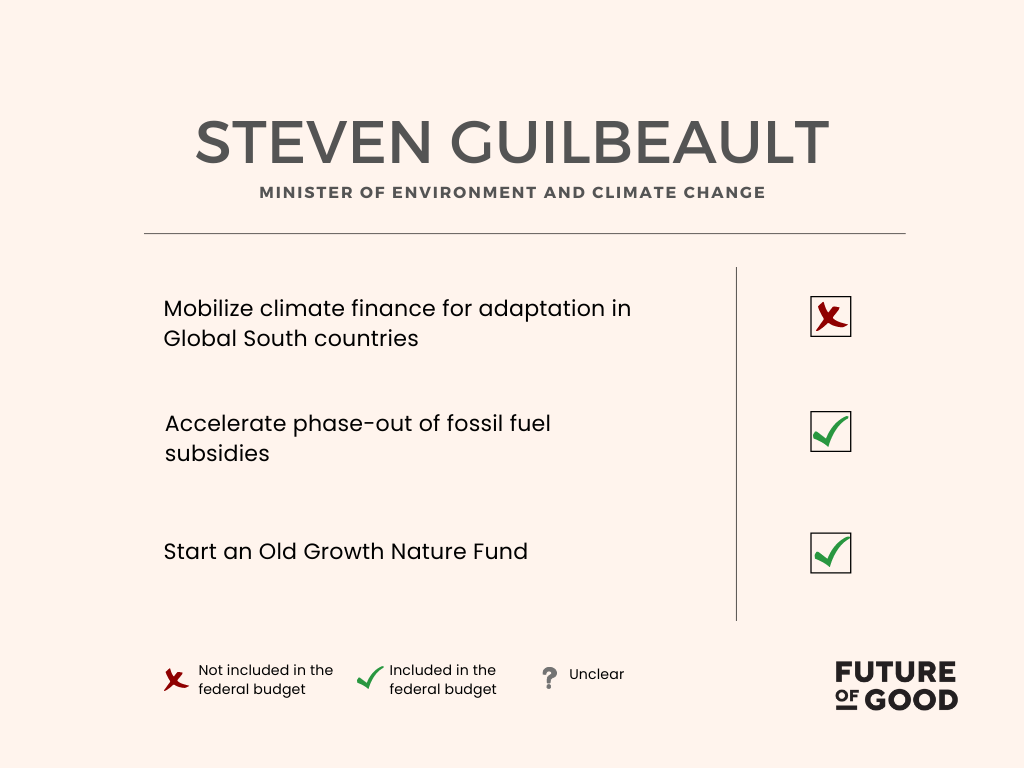
The take:
Despite the overwhelming emphasis on climate finance in the Intergovernmental Panel on Climate Change’s latest report, Canada’s 2022 budget doesn’t mention climate finance at all – let alone its mobilization to help Global South countries, especially island nations, adapt to the realities of a harsher climate. At the 2021 G7 Leaders’ Summit, Canada did promise to double its international finance commitment to $5.3 billion over the next five years, but additional funding didn’t show up this year.
The acceleration of phasing out fossil fuel subsidies (from 2025 to 2023) was announced just before the 2022 budget was tabled, but Guilbeault’s work isn’t done. Coming up with a plan to phase out public financing of the fossil sector, including by federal Crown corporations, is also on his agenda – and that plan has yet to materialize.
Guilbeault was asked to launch an Old Growth Nature Fund that involves First Nations, local communities, and workers, to ensure Canada’s old growth forests – especially in B.C. – are protected from logging. That agenda item did feature in the 2022 budget with a $55.1 million allocation over three years, slightly over the $50 million referenced in Guilbeault’s mandate letter.
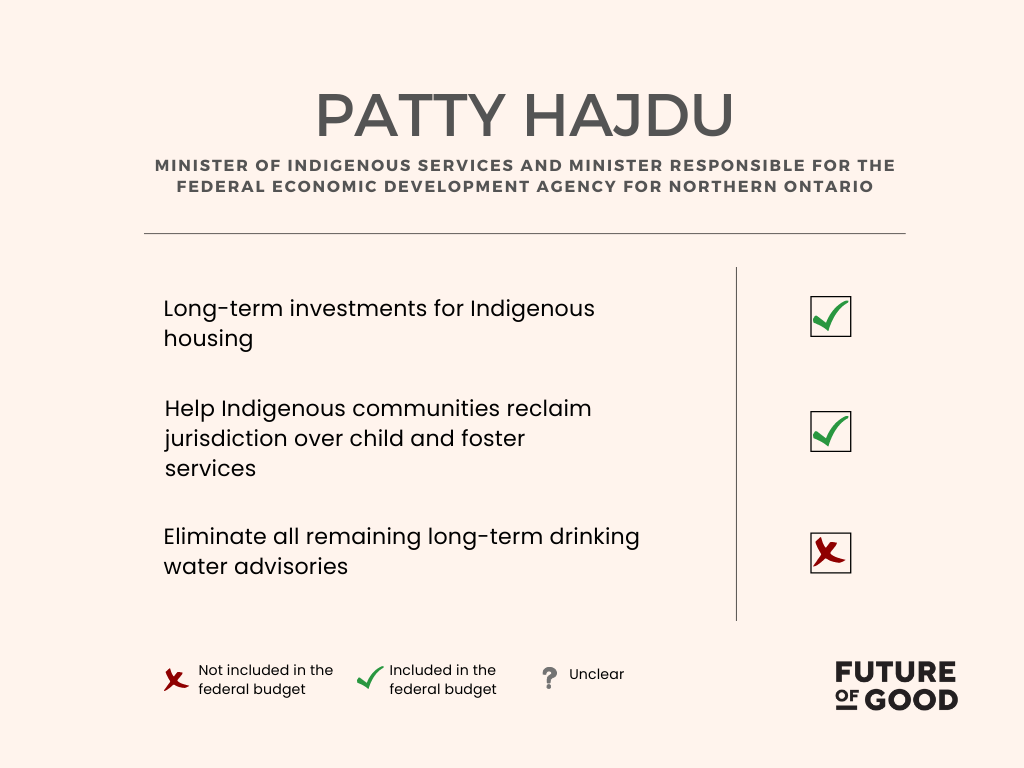
The take: One of the 2022 budget’s cornerstones was the $6.3 billion spent on Indigenous housing, ranging from affordable housing on-reserve to addressing housing precarity among urban Indigenous people. Minister Patty Hajdu can definitively cross off her mandate letter’s commitment to provide immediate and significant long-term Indigenous housing investments.
One of Hajdu’s ongoing priorities is giving Indigenous communities the chance to claim jurisdiction over healthcare, child and foster services, and justice. The 2022 budget gives $87.3 million over three years to help Indigenous communities hammer out their own child welfare laws and work with all levels of Canadian government to implement them.
Lifting all long-term drinking water advisories in Canada was one of Prime Minister Justin Trudeau’s campaign promises during his first election campaign in 2015. Not one of his Indigenous-focused Cabinet ministers has made it happen yet, and 2022 is no exception.
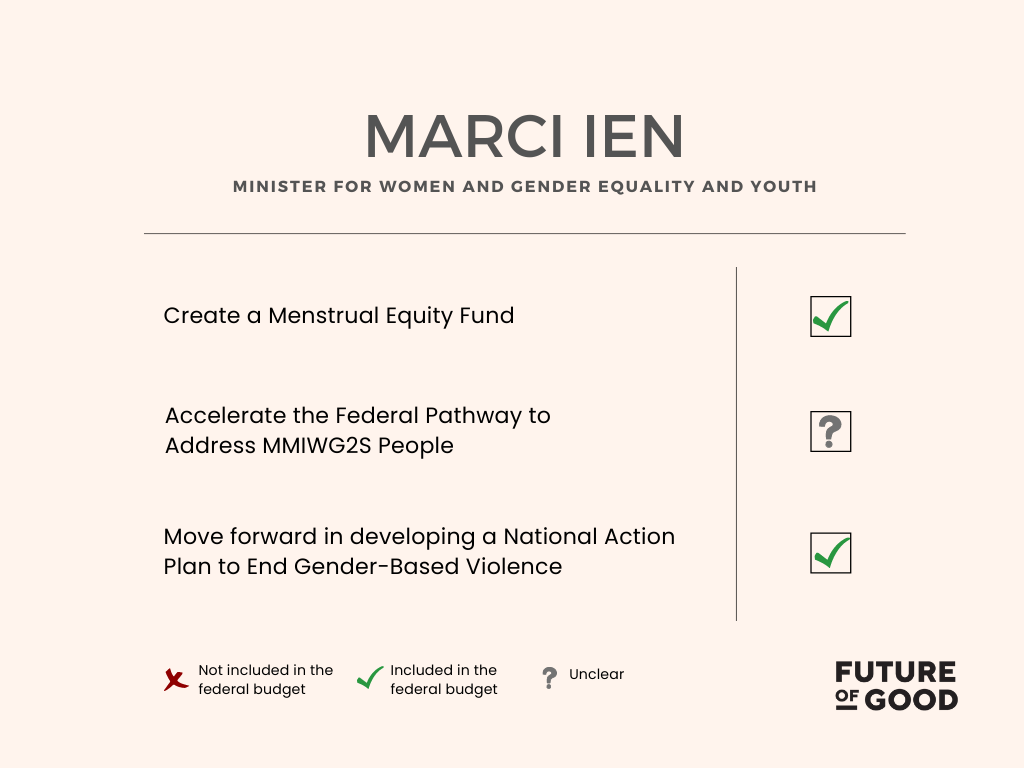
The take: As instructed in Minister Marci Ien’s mandate letter, a Menstrual Equity Fund showed up in the 2022 budget, although exactly how it will be implemented – and who will be eligible to apply – remains unclear. It may include grants to women, trans, and non-binary serving organizations.
The Federal Pathway to Address Missing and Murdered Indigenous Women, Girls, and 2SLGBTQQIA+ People first received federal funding in the 2021 budget – $2.2 billion over five years, and $160.9 million per year afterwards. No explicit mention of it was made in the 2022 budget, so it isn’t immediately clear whether the federal government’s latest fiscal plan accelerates the Federal Pathway in any meaningful way.
While the National Action Plan to End Gender-Based Violence isn’t finished yet, Ien’s mandate letter calls on her to begin negotiating with provinces and territories on it. That commitment is included in the 2022 budget. It also gives $539.3 million over five years to Women and Gender Equality Canada to help provinces and territories offer supports to survivors of gender-based violence – something that arguably goes beyond just ‘developing’ the National Action Plan.
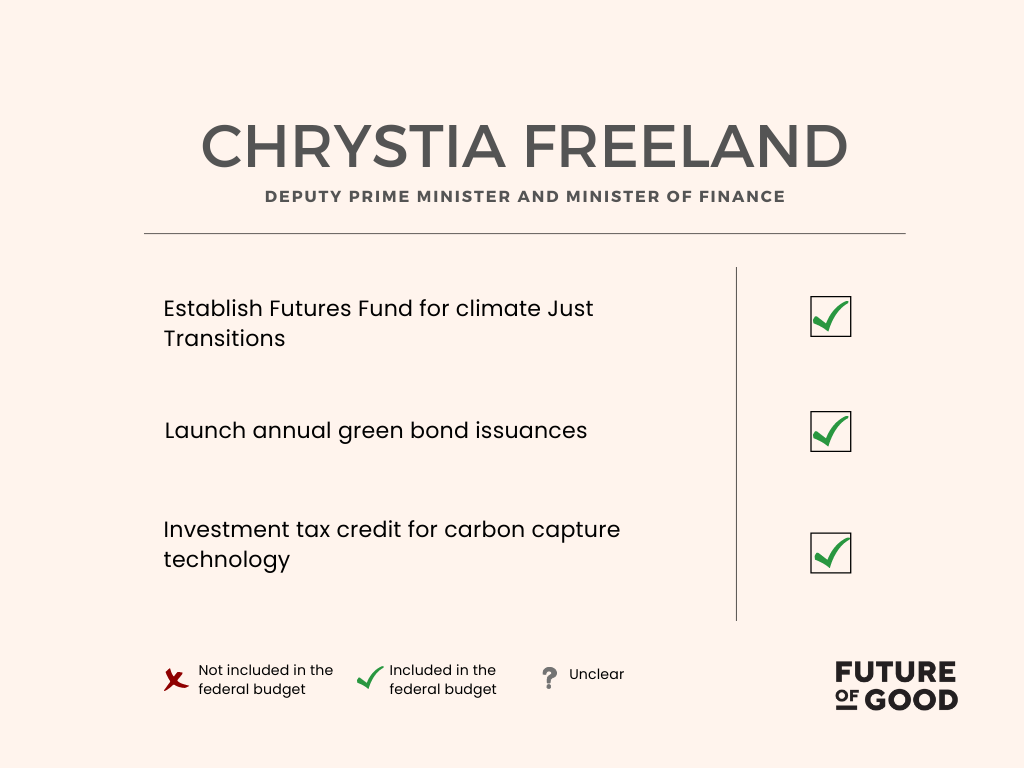
The take: Minister Chrystia Freeland is effectively a one-women Cabinet – her portfolio covers Canada’s global climate diplomacy, tackling financial crime, and raising corporate taxes. In March 2022, the federal government launched a Futures Fund to help Alberta, Saskatchewan, and Newfoundland and Labrador retrain workers to thrive in a low-carbon economy. This was just one month before the 2022 budget, but is captured in green spending programs.
Canada launched its green bond program in 2021 with an initial $5 billion offering. The 2022 budget promises to add another $5 billion this year, although a footnote says the exact amount issued as bonds will depend on market conditions.
The 2022 budget also mentions a new tax credit of up to 60 percent for equipment that captures carbon dioxide, and promises that the government will continue working on decarbonization through initiatives like the Canada Growth Fund and the Net-Zero Accelerator.
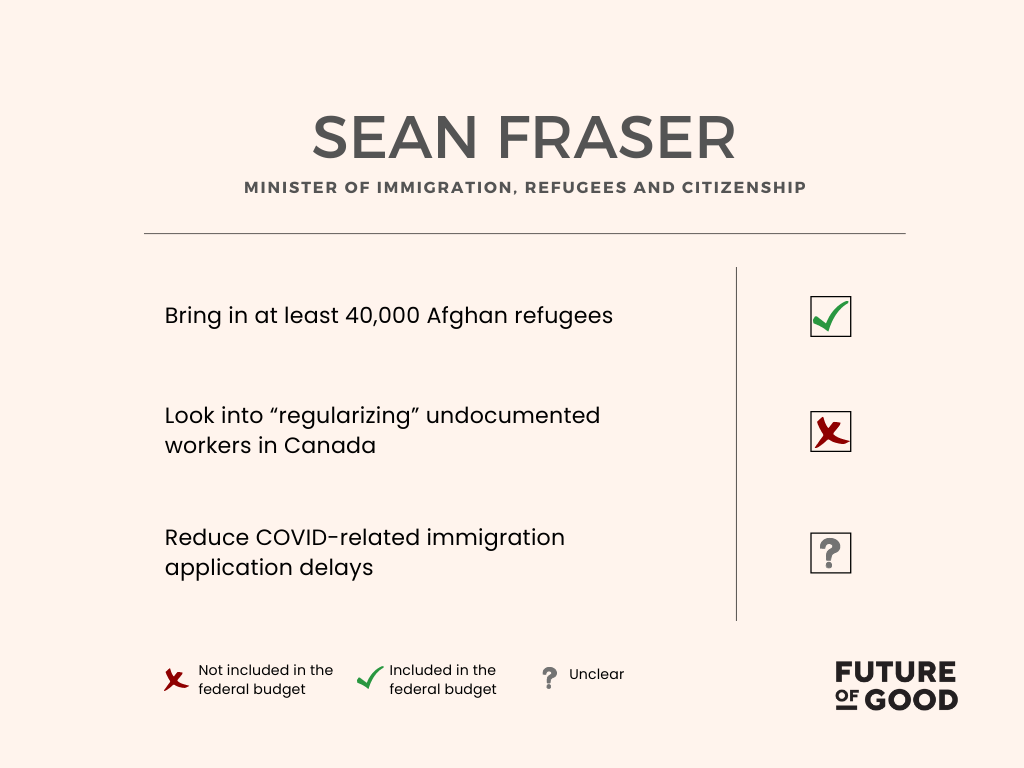
The take: Minister Sean Fraser’s mandate letter was drafted before the Ukrainian war and subsequent humanitarian crisis began, but he was already dealing with a host of other refugee crises: most notably, in Afghanistan. One of his major priorities was to double the number of Afghans eligible for refugee settlement in Canada to 40,000, especially if they assisted the Canadian military, women, LGBTQ people, human rights defenders, journalists, and ethnic minorities. Two months before the 2022 budget was released, the federal government’s Immigration Levels’ Plan approved that increase.
Research into regularizing undocumented workers in Canada (many of whom work, contribute to their communities, and even pay taxes) has been explored in Canada, but mainly at the provincial level. Quebec briefly ran a program that gave asylum seekers who’d worked in Canada’s healthcare system – but had been denied refugee status – a path to permanent residency. However, the 2022 budget doesn’t offer any concrete policies on regularizing undocumented workers.
The federal government gave immigrant support services a raise in the 2022 federal budget, but it isn’t clear whether the additional $385.7 million over five years will simply address pre-existing issues in Canada’s immigration system, or if it’s also intended to handle COVID-related backlogs as well.
